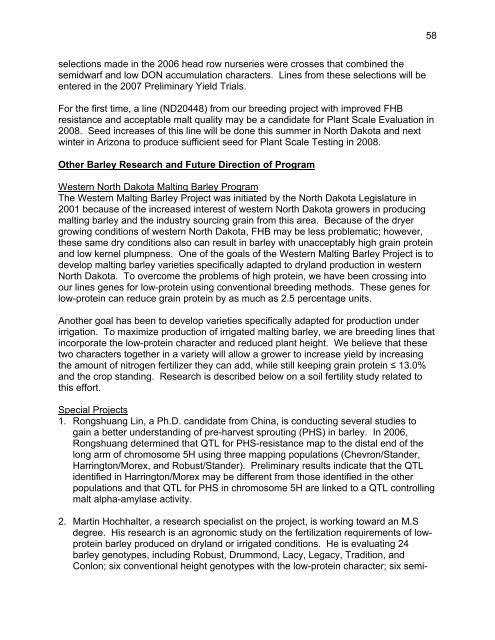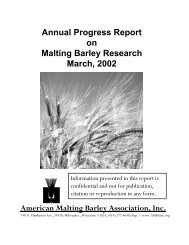Annual Progress Report on Malting Barley Research March, 2007
Annual Progress Report on Malting Barley Research March, 2007
Annual Progress Report on Malting Barley Research March, 2007
You also want an ePaper? Increase the reach of your titles
YUMPU automatically turns print PDFs into web optimized ePapers that Google loves.
selecti<strong>on</strong>s made in the 2006 head row nurseries were crosses that combined the<br />
semidwarf and low DON accumulati<strong>on</strong> characters. Lines from these selecti<strong>on</strong>s will be<br />
entered in the <strong>2007</strong> Preliminary Yield Trials.<br />
For the first time, a line (ND20448) from our breeding project with improved FHB<br />
resistance and acceptable malt quality may be a candidate for Plant Scale Evaluati<strong>on</strong> in<br />
2008. Seed increases of this line will be d<strong>on</strong>e this summer in North Dakota and next<br />
winter in Ariz<strong>on</strong>a to produce sufficient seed for Plant Scale Testing in 2008.<br />
Other <strong>Barley</strong> <strong>Research</strong> and Future Directi<strong>on</strong> of Program<br />
Western North Dakota <strong>Malting</strong> <strong>Barley</strong> Program<br />
The Western <strong>Malting</strong> <strong>Barley</strong> Project was initiated by the North Dakota Legislature in<br />
2001 because of the increased interest of western North Dakota growers in producing<br />
malting barley and the industry sourcing grain from this area. Because of the dryer<br />
growing c<strong>on</strong>diti<strong>on</strong>s of western North Dakota, FHB may be less problematic; however,<br />
these same dry c<strong>on</strong>diti<strong>on</strong>s also can result in barley with unacceptably high grain protein<br />
and low kernel plumpness. One of the goals of the Western <strong>Malting</strong> <strong>Barley</strong> Project is to<br />
develop malting barley varieties specifically adapted to dryland producti<strong>on</strong> in western<br />
North Dakota. To overcome the problems of high protein, we have been crossing into<br />
our lines genes for low-protein using c<strong>on</strong>venti<strong>on</strong>al breeding methods. These genes for<br />
low-protein can reduce grain protein by as much as 2.5 percentage units.<br />
Another goal has been to develop varieties specifically adapted for producti<strong>on</strong> under<br />
irrigati<strong>on</strong>. To maximize producti<strong>on</strong> of irrigated malting barley, we are breeding lines that<br />
incorporate the low-protein character and reduced plant height. We believe that these<br />
two characters together in a variety will allow a grower to increase yield by increasing<br />
the amount of nitrogen fertilizer they can add, while still keeping grain protein ≤ 13.0%<br />
and the crop standing. <strong>Research</strong> is described below <strong>on</strong> a soil fertility study related to<br />
this effort.<br />
Special Projects<br />
1. R<strong>on</strong>gshuang Lin, a Ph.D. candidate from China, is c<strong>on</strong>ducting several studies to<br />
gain a better understanding of pre-harvest sprouting (PHS) in barley. In 2006,<br />
R<strong>on</strong>gshuang determined that QTL for PHS-resistance map to the distal end of the<br />
l<strong>on</strong>g arm of chromosome 5H using three mapping populati<strong>on</strong>s (Chevr<strong>on</strong>/Stander,<br />
Harringt<strong>on</strong>/Morex, and Robust/Stander). Preliminary results indicate that the QTL<br />
identified in Harringt<strong>on</strong>/Morex may be different from those identified in the other<br />
populati<strong>on</strong>s and that QTL for PHS in chromosome 5H are linked to a QTL c<strong>on</strong>trolling<br />
malt alpha-amylase activity.<br />
2. Martin Hochhalter, a research specialist <strong>on</strong> the project, is working toward an M.S<br />
degree. His research is an agr<strong>on</strong>omic study <strong>on</strong> the fertilizati<strong>on</strong> requirements of lowprotein<br />
barley produced <strong>on</strong> dryland or irrigated c<strong>on</strong>diti<strong>on</strong>s. He is evaluating 24<br />
barley genotypes, including Robust, Drumm<strong>on</strong>d, Lacy, Legacy, Traditi<strong>on</strong>, and<br />
C<strong>on</strong>l<strong>on</strong>; six c<strong>on</strong>venti<strong>on</strong>al height genotypes with the low-protein character; six semi-<br />
58
















